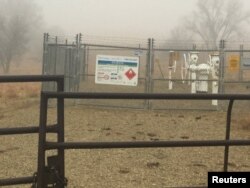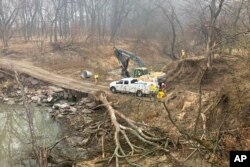The effort to remove oil from the largest crude spill in the United States in nearly a decade will extend into next week, the U.S. Environmental Protection Agency said Friday, making it likely that the Keystone pipeline shutdown will last for several more days.
TC Energy shut the largest oil pipeline to the United States from Canada on Wednesday after it leaked 14,000 barrels of oil into a Kansas creek. It said on Friday it is still determining when it will be able to return the line to service.
The outage on the Keystone, which carries 622,000 barrels of Canadian crude per day to various parts of the United States, could affect inventories at the key Cushing, Oklahoma, storage hub and cut crude supplies to two oil refining centers, analysts said. Crews in Kansas continued cleanup efforts on Friday, but the cause of the spill remained unknown.
“We’re beginning to get a better sense of the cleanup efforts that will need to be undertaken in the longer term,” said Kellen Ashford, spokesperson for the EPA Region 7, which includes Kansas.
TC Energy aims to restart on Saturday a pipeline segment that sends oil to Illinois, and another portion that brings oil to Cushing on December 20, Bloomberg News reported, citing sources. Reuters has not verified those details.
This is the third spill of several thousand barrels of crude on the pipeline since it first opened in 2010. A previous Keystone spill had caused the pipeline to remain shut for about two weeks.
The spill is in Washington County, a rural area of about 5,500 people about 320 kilometers northwest of Kansas City.
The oil spill has not threatened the local water supply or forced residents to evacuate, Washington County Emergency Management Coordinator Randy Hubbard told Reuters. Workers quickly set up a containment area to restrict oil that had spilled into a creek from flowing downstream.
“There is no human consumption drinking water that would come out of this,” Hubbard said.
Livestock producers in the area have been notified and have taken their own corrective measures to protect their animals, he added.
The EPA is the main federal agency that oversees inland oil spills. If the EPA finds TC Energy liable for the spill, the company would be responsible for the cost of cleanup and repairing any harm to the environment, as well as potential civil and criminal penalties.
Pipeline operators are typically held accountable for breaches by the EPA through the Clean Water Act (CWA) and the related Oil Pollution Act, among others, according to Zygmunt Plater, an environmental law professor at Boston College Law School.
Those federal acts restrict the discharge of pollutants such as oil into waterways and hold pipeline operators responsible for the costs associated with containment, cleanup and damages from spills.
A lengthy shutdown of the pipeline could also lead to Canadian crude getting bottlenecked in Alberta, and drive prices at the Hardisty storage hub lower, although price reaction on Friday was muted.
The Pipeline and Hazardous Materials Safety Administration has to approve the restart of the line. Even once the pipeline starts operating again, the affected area will have to flow at reduced rates pending PHMSA approval.


